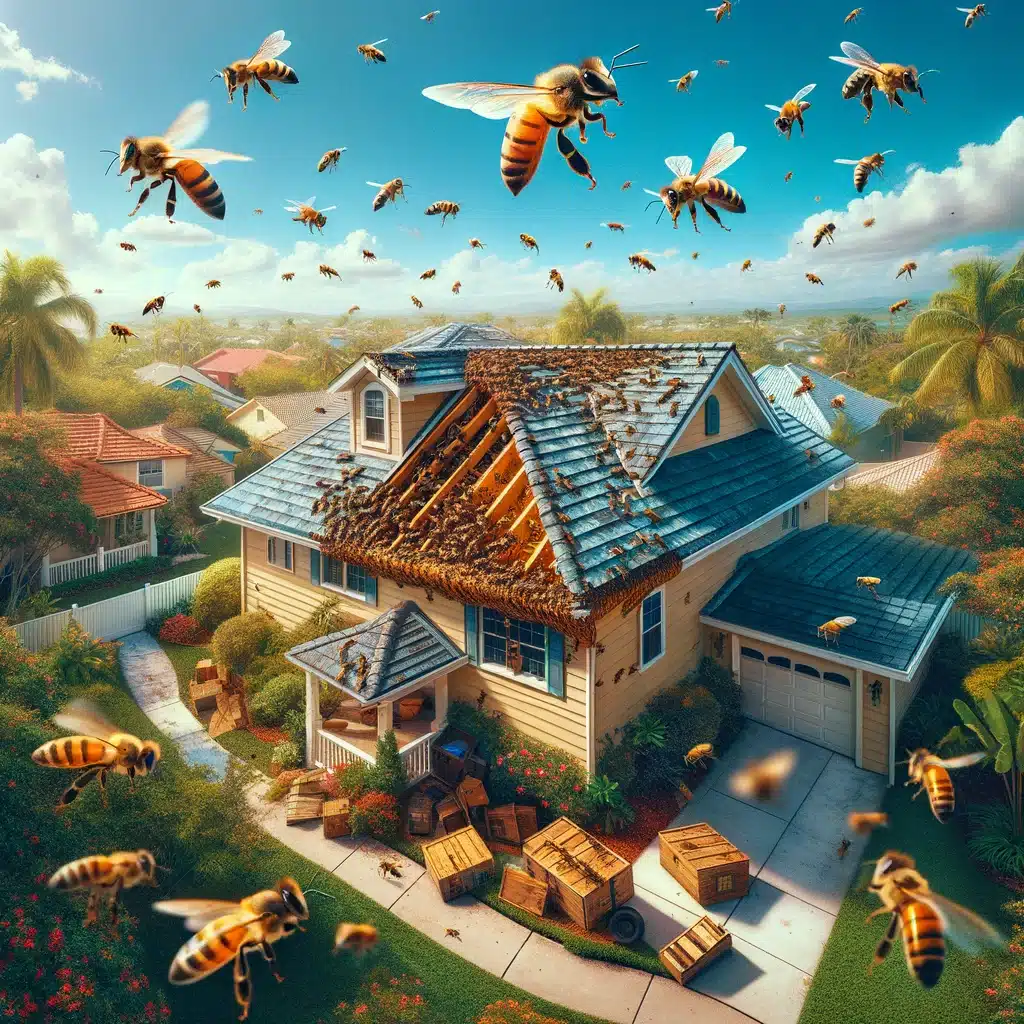Facing a Bee Infestation on Your Roof? How does this happen?
Honey, synonymous with sweetness and the gentle hum of bees on warm summer nights, becomes less appealing when it starts buzzing through your walls and nesting in your roof. But why does this happen?
You got a bee infestation. Honey bees often choose the spaces under shingles and on roofs to establish their colonies. This presents some challenges for homeowners, because of the damage it can cause to your roof, but you can take action to address the issue.
The Reason Behind Bees Choosing Your Roof
Roofs in Florida can indeed become very hot, but bees are adept at regulating the temperature of their hives. They use several methods to cool the hive, such as fanning with their wings to circulate air and collecting water to evaporate inside for cooling. While extreme heat can be challenging, bees often choose shaded or ventilated areas under roof structures to mitigate these conditions, allowing them to maintain hives even in Florida’s hot climate.
Bee scouts play a crucial role in the hive by searching for new food sources and potential sites for new colonies. During swarming, when a colony splits to form a new one, scouts are responsible for finding a suitable location for the new hive. They explore various options, return to the swarm, and use dances to advocate for their chosen site. The swarm then makes a collective decision based on the scouts’ recommendations. If your roof is selected, then you have a problem.
Entry Points for Bees into Your Roof
Scouts seek a dark, secluded spot for the colony. They can nest in your roof if they find a hole, usually through gaps in bricks or at points where siding materials meet, relying on pre-existing openings to establish their home.
Identifying a Bee Infestation
The unmistakable buzz inside your walls or roof is a clear sign of infestation, alongside increased bee activity around your home. Dark, sticky honey leaking through walls or downpipes is another indication of a bee problem.
Preventing Bee Infestations in Florida
Roofs in Florida are more prone to bee infestations due to the state’s warm climate, which is ideal for bee activity year-round. Florida’s diverse flora provides abundant food sources, encouraging bees to establish hives in sheltered areas, including roofs.
Roof vents can pose a risk for bee infestations. These vents provide bees with an easy access point to sheltered areas where they can build hives. The warmth and protection from predators and the elements make roof vents attractive sites for bees. To mitigate this risk, ensure vents are properly screened.
The most effective prevention method is ensuring your roof has no entry points, such as holes or cracks. Annual inspections by a roofing contractor can help identify and seal these potential entrances. Regular inspections and maintenance can help prevent infestations.
The Risks of DIY Bee Removal
Attempting to remove bees yourself can provoke them, potentially leading to more serious issues. Beyond removing the bees, it’s crucial to also eliminate any remaining honey and debris, a task requiring specialized skills and equipment.
If you’re facing a bee infestation on your roof, seeking professional assistance is crucial. Bees in Florida are not generally considered poisonous; however, their stings can cause allergic reactions in some individuals, ranging from mild irritation to severe anaphylactic shock. Most Florida bees, like honeybees, are not aggressive and sting only in defense. It’s important to exercise caution around bees and seek medical attention if you experience a severe reaction to a bee sting.
Addressing the Aftermath of an Infestation
Dealing with an infestation can significantly disrupt your life and damage your roof. Professional beekeepers are essential for safely relocating the bees. Afterwards, hiring a qualified roofer to repair the damage and replace affected shingles is necessary.
Bees can damage roofs by building hives in vents, under tiles, or in cavities. The weight of a large hive can stress roof structures. Hives can block ventilation, leading to moisture problems. Bees entering and exiting create wear on materials. Removing hives often requires parts of the roof to be disturbed or removed, potentially leading to leaks or structural damage.
